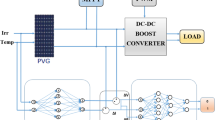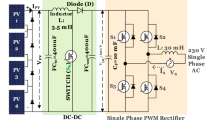Abstract
The maximum power point tracking (MPPT) controller holds an important role in increasing the efficiency of the photovoltaic (PV) system. However, conventional MPPT techniques may fail to locate the global maximum power point (GMPP) under partial shading conditions (PSC). Hence, to optimize the efficiency of PV systems, we introduce a new MPPT technique for PSC. The proposed method employs an artificial neural network (ANN) to predict the area of the GMPP, and the classic perturb and observe (P&O) algorithm to locate the exact position of the GMPP. We validated the effectiveness of the technique using computer simulations performed with the MATLAB/Simulink program, the results of which verified that it can track the GMPP faster than other methods.










Similar content being viewed by others
REFERENCES
Bastidas-Rodriguez, J.D., Spagnuolo, G., Franco, E., et al., Maximum power point tracking architectures for photovoltaic systems in mismatching conditions: a review, IET Power Electron., 2014, vol. 7, no. 6, pp. 1396–1413.
Xiao, W., Lind, M.G.J., Dunford, W.G., and Capel, A., Real-time identification of optimal operating points in photovoltaic power systems, IEEE Trans. Ind. Electron., 2006, vol. 53, no. 4, pp. 1017–1026.
Mouna, B.H. and Lassaâd, S., A maximum power tracking algorithm based on photovoltaic current control for matching loads to a photovoltaic generator, Appl. Sol. Energy, 2012, vol. 48, no. 4, pp. 238–244. https://link.springer.com/journal/11949/48/4/page/1. Accessed January 25, 2019.
Leyva, R., Alonso, C., Queinnec, I., et al., MPPT of photovoltaic systems using extremum-seeking control, IEEE Trans. Aerosp. Electron. Syst., 2006, vol. 42, no. 1, pp. 249–258.
Padmanabhan, V., Beena, V., and Jayaraju, M., Fuzzy logic based maximum power point tracker for a photovoltaic system, in Proc. Int. Conf. on Power, Signals, Controls and Computation (EPSCICON), 2012.
Messalti, S., Harrag, A.G., and Loukriz, A.E., A new neural networks MPPT controller for PV systems, in Proc. 6th Int. Renewable Energy Congress (IREC), 2015, pp. 1–6.
Kurniawan, A., Koenhardono, E.S., Masroeri, A.A., et al., Optimizing solar-powered tourist boat with converter-based maximum power point tracker, Int. J. Appl. Eng. Res., 2016, vol. 11, no. 23, pp. 11142–11144. https://www.ripublication.com/Volume/ijaerv11n23.htm. Accessed January 10, 2017.
Chaouachi, A., Kamel, R.M., and Nagasaka, K., A novel multi-model neuro-fuzzy-based MPPT for three-phase grid-connected photovoltaic system, Sol. Energy, 2010, vol. 84, no. 12, pp. 2219–2229.
Kurniawan, A., Masroeri, A.A., and Koenhardono, E.S., Neuro-fuzzy based maximum power point tracker for photovoltaic system on a moving vehicle, IPASJ Int. J. Comput. Sci., 2016, vol. 4, no. 10, pp. 1–9. https://ipasj.org/issue1.php?vol=Volume4Issue10&Jname=0. Accessed November 6, 2016.
Cheng, Z., Zhou, H., and Yang, H., Research on MPPT control of PV system based on PSO algorithm, in Proc. Chinese Control and Decision Conf. (CCDC), 2010, pp. 887–892.
Motahhir, S., El Ghzizal, A., Sebti, S., and Derouich, A., Shading effect to energy withdrawn from the photovoltaic panel and implementation of DMPPT using C language, Int. Rev. Autom. Control, 2016, vol. 9, no. 2, pp. 88–94. https://www.praiseworthyprize.org/jsm/index.php? journal=ireaco&page=article&op=view&path%5B%5D= 18778. Accessed October 22, 2019.
Li, X., Wen, H., Hu, Y., et al., Modified beta algorithm for GMPPT and partial shading detection in photovoltaic systems, IEEE Trans. Power Electron., 2018, vol. 33, no. 3, pp. 2172–2186.
Ramli, M.A.M., Twaha, S., Ishaque, K., and Al-Turki, Y.A., A review on maximum power point tracking for photovoltaic systems with and without shading conditions, Renewable Sustainable Energy Rev., vol. 67, pp. 144–159, 2017.
Dolara, A., Leva, S., Magistrati, G., et al., A novel MPPT algorithm for photovoltic systems under dynamic partial shading—Recurrent scan and track method, in Proc. 5th Int. Conf. on Renewable Energy Research and Applications, 2016, pp. 1122–1127.
Bouilouta, A., Mellit, A., and Kalogirou, S.A., New MPPT method for stand-alone photovoltaic systems operating under partially shaded conditions, Energy, vol. 55, 2013, pp. 1172–1185.
Qi, J., Zhang, Y., and Chen, Y., Modeling and maximum power point tracking (MPPT) method for PV array under partial shade conditions, Renewable Energy, 2014, vol. 66, pp. 337–345.
Sellami, A., Kandoussi, K., El Otmani, R., et al., A novel auto-scaling MPPT algorithm based on perturb and observe method for photovoltaic modules under partial shading conditions, Appl. Sol. Energy, 2018, vol. 54, no. 3, pp. 149–158. https://link.springer.com/journal/11949/54/3. Accessed January 23, 2019.
Hua, C.C. and Chen, Y.M., Modified perturb and observe MPPT with zero oscillation in steady-state for PV systems under partial shaded conditions, in Proc. IEEE Conf. on Energy Conversion (CENCON), 2017, pp. 5–9.
Patel, H. and Agarwal, V., Maximum power point tracking scheme for PV systems operating under partially shaded conditions, IEEE Trans. Ind. Electron., 2008, vol. 55, no. 4, pp. 1689–1698.
Jiang, L.L., Maskell, D.L., and Patra, J.C., A novel ant colony optimization-based maximum power point tracking for photovoltaic systems under partially shaded conditions, Energy Build., 2013, vol. 58, pp. 227–236.
Kumar, N., Hussain, I., Singh, B., and Panigrahi, B.K., Single sensor based MPPT for partially shaded solar photovoltaic by using human psychology optimisation algorithm, IET Gener. Transm. Distrib., 2017, vol. 11, no. 10, pp. 2562–2574.
Telbany, M.E.E., Youssef, A., and Zekry, A.A., Intelligent techniques for MPPT control in photovoltaic systems: A comprehensive review, in Proc. 4th Int. Conf. on Artificial Intelligence with Applications in Engineering and Technology (ICAIET), 2014, pp. 17–22.
Punitha, K., Devaraj, D., and Sakthivel, S., Artificial neural network based modified incremental conductance algorithm for maximum power point tracking in photovoltaic system under partial shading conditions, Energy, 2013, vol. 62, pp. 330–340.
Jiang, L. and Maskell, D.L., A simple hybrid MPPT technique for photovoltaic systems under rapidly changing partial shading conditions, in Proc. 40th IEEE Photovolt. Spec. Conf. (PVSC), 2014, pp. 782–787.
Bouselham, L., Hajji, M., Hajji, B., and Bouali, H., A new MPPT-based ANN for photovoltaic system under partial shading conditions, Energy Procedia, vol. 111, March 2017, pp. 924-933, 2017.
El-Helw, H.M., Magdy, A., and Marei, M. I., A hybrid maximum power point tracking technique for partially shaded photovoltaic arrays, IEEE Access, 2017, vol. 5, pp. 11900–11908.
Kurniawan, A., Haryanto, E., and Masroeri, A.A., A neural network based maximum power point tracker with KY converter for photovoltaic system on a moving vehicle, in Proc. Int. Conf. on Advanced Mechatronics, Intelligent Manufacture, and Industrial Automation (ICAMIMIA), 2015, pp. 117–120.
Chouder, A. and Silvestre, S., Automatic supervision and fault detection of PV systems based on power losses analysis, Energy Convers. Manag., 2010, vol. 51, no. 10, pp. 1929–1937.
Villalva, M.G., Gazoli, J.R., and Ruppert Filho, E., Modeling and circuit-based simulation of photovoltaic arrays, Brazilian J. Power Electron., 2009, vol. 14, no. 1, pp. 35–45.
Yu, H. and Wilamowski, B.M., Levenberg–Marquardt Training, in The Industrial Electronics Handbook, Wilamowski, B.M. and Irwin, J.D., Eds., Boca Raton: CRC, 2011, ch. 12, pp. 12.1–12.16.
Kurniawan, A. and Shintaku, E., Control of photovoltaic system connected to DC bus in all-electric ship, in Proc. Int. Conf. on Advanced Mechatronics, Intelligent Manufacture, and Industrial Automation (ICAMIMIA), 2017, pp. 110–115.
Ahmed, J. and Salam, Z., A maximum power point tracking (MPPT) for PVS system using cuckoo search with partial shading capability, Appl. Energy, 2014, vol. 119, pp. 118–130.
ACKNOWLEDGMENTS
This study is supported by the Hitachi Global Foundation as the scholarship provider for the first author. The authors express their sincere appreciation to this organization.
Author information
Authors and Affiliations
Corresponding author
About this article
Cite this article
Adi Kurniawan, Eiji Shintaku A Neural Network-Based Rapid Maximum Power Point Tracking Method for Photovoltaic Systems in Partial Shading Conditions. Appl. Sol. Energy 56, 157–167 (2020). https://doi.org/10.3103/S0003701X20030068
Received:
Revised:
Accepted:
Published:
Issue Date:
DOI: https://doi.org/10.3103/S0003701X20030068




